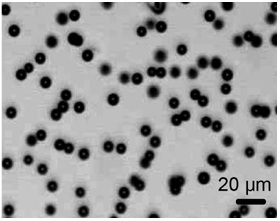Microfluidics is a very successful technology widely used to produce droplets with sizes in the range of 10-200 µm. However, the production and behaviour of droplets smaller than this, around 1 µm, has not really been explored. Droplets of this size are highly desirable due, amongst other things, to their biomedical applications.
There are a number of possible methods, which could be used to generate micron sized droplets. Kumacheva et al. formed bubbles of < 10 µm using a dissolution technique. Micro-bubbles of 50-100 µm were formed initially and allowed to carefully dissolve until they reached the desired size. Anna et al., on the other hand, used tip streaming through a flow focusing device to form micron sized liquid drops. While both of these methods have successfully formed droplets smaller than 10 µm, droplet formation using these techniques can be hard to control as both methods rely on specific physiochemical conditions and have relatively low throughputs.
In a recent talk, Patrick Tabeling discussed a brute force method, which he used to form simple droplets, multiple droplets, particles and Janus particles with diameters of 900 nm – 3 µm. The microfluidic devices used by Tabeling et al. contain a submicrometric channel, with a cross junction (where the dispersed and continuous phases meet), followed by a terrace. The interface between the two fluids forms a tongue as it flows down the nanofluidic terrace. The terrace empties into a reservoir, who’s depth is much greater than that of the nanochannel. As the tongue tip crosses into the reservoir it becomes unstable and droplets are formed. Highly monodisperse droplets can be generated using this technique at a rate of 5-15 kHz.
In his talk, Tabeling demonstrated the use of these micron sized droplets for targeted drug delivery in rats. Fluorescence containing droplets were injected into rats, targeted disruption of the droplets and delivery of the fluorescence was achieved using acoustic waves.











